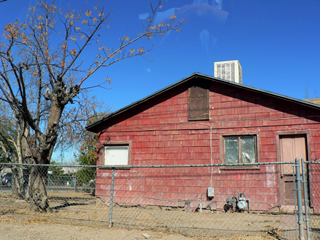|
 As I
drove through the streets of South Phoenix, it was hard for
me to make sense of the place. Is it a place that we can
call, to borrow from a postmodernist’s lingo, hybrid? Or,
is the place a by-product of the city planner’s
imagination? But one thing that I am sure of is that South
Phoenix represents a palimpsest of spatial, temporal,
textual and cultural layers. It is not just a trope for an
inner city; it is also a place that signifies racial divide
between north and south in the city of Phoenix, an idea
bolstered by the Morrison Institute of Public Policy’s
Hits and Misses: Fast Growth in Metropolitan Phoenix
(2000:22) and more poignantly by the article of Bolin et al
entitled “The Geography of Despair: Environmental Racism and
the Making of South Phoenix, Arizona, USA” (2005). Like de
Certeau’s “Walking in the City,” this “windshield” tour was
an act of narrative enunciation. It allowed me to read the
layers of texts inscribed in the landscape of South
Phoenix. The driving tour became an archive and a chronicle
of history and urban text of South Phoenix. As I
drove through the streets of South Phoenix, it was hard for
me to make sense of the place. Is it a place that we can
call, to borrow from a postmodernist’s lingo, hybrid? Or,
is the place a by-product of the city planner’s
imagination? But one thing that I am sure of is that South
Phoenix represents a palimpsest of spatial, temporal,
textual and cultural layers. It is not just a trope for an
inner city; it is also a place that signifies racial divide
between north and south in the city of Phoenix, an idea
bolstered by the Morrison Institute of Public Policy’s
Hits and Misses: Fast Growth in Metropolitan Phoenix
(2000:22) and more poignantly by the article of Bolin et al
entitled “The Geography of Despair: Environmental Racism and
the Making of South Phoenix, Arizona, USA” (2005). Like de
Certeau’s “Walking in the City,” this “windshield” tour was
an act of narrative enunciation. It allowed me to read the
layers of texts inscribed in the landscape of South
Phoenix. The driving tour became an archive and a chronicle
of history and urban text of South Phoenix. |